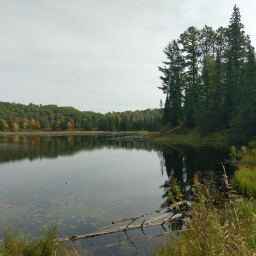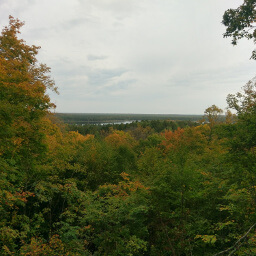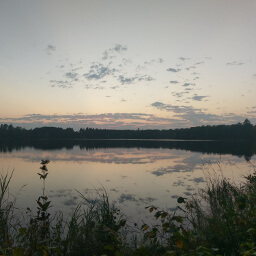| Rating | ★★★★☆(4/5) |
| Overall Difficulty | Easy |
| Navigation Difficulty | Easy |
| Distance | 0.75 miles roundtrip |
| Time | 1 hour |
| Terrain | Mostly flat |
| Best Seasons | Spring, Summer, Fall |
| Family Friendly | Yes |
| Dog Friendly | Yes |
| Accessible | Yes |
Highlights
- Wildlife viewing platform
- Scenic forest and prairie
Hike Summary
In the land of 10,000 lakes and where wild rice grows in abundance, it's not surprising that there are over 50 lakes named "Rice Lake" in Minnesota (check out the Minnesota Department of Natural Resources LakeFinder to see for yourself). Here is your chance to see an excellent example of a wild rice filled lake so you may understand the Rice Lake naming phenomenon. This post will be slightly different than previous hikes in that I will describe a few routes you can take depending on your needs rather than just one (it doesn't make sense to have three posts about the same trail).
Visiting a park outside of the Minnesota State Parks is nice for a change. National Wildlife Refuges are federally designated lands primarily devoted to managing the population of a wide variety of plants and animals, and recreation takes a back seat (which is why you can't fish or canoe or swim or even touch Rice Lake). Surprisingly, the word "refuge" here doesn't mean this is a safe haven for wildlife where everything can live and grow in reckless abandon; hunting is allowed in parts of this park and many other National Wildlife Refuges. Humans are a necessary predator to manage the populations of various game since natural predators aren't numerous enough here to keep the ecosystem in balance. Maybe it's just in my head, but in my experience, National Wildlife Refuges seem to have larger bird populations than other types of public lands.
Dogs are allowed on leash on all of the trails in the park. I came here on a cloudy, rainy Monday afternoon, so I'm not even going to pretend to know how many people normally come here. Given that you can drive to the viewing platform on Rice Lake, I would expect a minute proportion of people hike the Rice Lake Trail. The other trails are short and easy so expect to see people when it's nice out. During winter, trails are open for snowshoeing (and presumably hiking); however, the park road is closed from the Mandy Lake parking area on, so you must add about 2 miles roundtrip to your journey.
Accessible Route
The accessible route is significantly shorter than all of the other routes since the only accessible trail in the park is a quarter mile paved loop by the Twin Lakes parking area. Some of the prettiest sights in the park are the Twin Lakes that you can see from the parking lot; you can have a view similar to the picture below without having to go to the dock at the bottom the a hill. The loop trail circles through the forest and provides a taste of the landscape present in the rest of the park.
The Twin Lakes Loop is an excellent family friendly trail that is short but scenic, 0.75 miles long rountrip as displayed at the top of the page. Follow the paved trail heading east from the parking lot, then turn right at the first unpaved trail. Most of the intersections here have a map, but note that some (but not all) of the maps are oriented with north facing down rather than up -- if the map looks funny, look for the north arrow! The trail is flat and wide, and you will have views of the Twin Lakes on your right like shown in the picture at the top of the page. Turn right at the intersection ahead to loop through the forest. The trail makes a U-shape, then you turn left at the intersection. Continue straight and you will retrace your steps back to the parking lot. Be sure to drive to the viewing platform at Rice Lake as described at the end of the previous section!
Long Route
This route is a little over 5 miles long roundtrip. Start by following the Twin Lakes Loop as described in the previous family friendly route, except once you reach the end of the U, turn right and then right again to take the Rice Lake Trail. The forest in this first part wasn't particularly exciting (though I'm sure it's lovely when fall colors peak), and this is the part of the trail that drags on the return trip. However, once you emerge from the forest, you will find a wide open prairie. In spring, summer, and early fall, expect to see beautiful wildflowers here. Unfortunately, for the rest of fall these grasses don't change vibrant colors like the surrounding trees -- they just die and turn black or brown (see picture below). In winter, this is basically the tundra. The long slog through forest wasn't for nought, and after passing the prairie you will see a the marsh pictured below. If you're lucky, you'll see some waterfowl other than geese or ducks (I saw a swan!). This portion of the trail really made the long haul worth it.

If you look closely at this marsh photo, you can find a white swan near the island in the pond
View full size
Retrace your steps on the Rice Lake Trail all the way back to the parking lot. The map above shows that I took the North Bog Trail, but you can skip this if you want; after spending the weekend in Savanna Portage State Park, I became well versed in the peat bog environment and I was disappointed that there was no bog to be found on this so called North Bog Trail.
Rice Lake National Wildlife Refuge can meet all of your hiking needs with a scenic walk through well preserved wetlands and forest. This is an excellent stop during any road trip on Minnesota Highway 65, and definitely worth a stop if you are visiting Savanna Portage State Park for the weekend. Let me know what you think in the comments section below, and be sure to use #nocoastbestcoast on Twitter and Instagram!
Directions
From the Twin Cities, take Interstate 35W north to U.S. Highway 10 west. In Blaine, exit for Minnesota Highway 65 (Central Avenue) and turn right. Follow Minnesota Highway 65 north for about 2 hours. In the town of East Lake, you will see some buildings and a sign for Rice Lake National Wildlife Refuge on the left, then turn left into the park. You don't have to stop at the park office on the left, but they have a staff person and a variety of maps and brochures if you want information. Continue straight on the dirt park road. After the road curves to the left, the parking area will be on the left.
Google Maps Directions
Parking, Fees, and Facilities
Parking is free! The Twin Lakes lot has one accessible parking space and an accessible portable toilet (not available in winter), and the Rice Lake lot has two pit toilets and an accessible viewing platform with free-to-use telescopes.
Nearby Hikes

Savanna Portage State Forest, Minnesota
★★★★☆(4/5)

Savanna Portage State Park, Minnesota
★★★★★(5/5)

Savanna Portage State Park, Minnesota
★★★★★(5/5)

Savanna Portage State Park, Minnesota
★★★★☆(4/5)


